10 Retro Wall Art Ideas to Transform Your Space Instantly
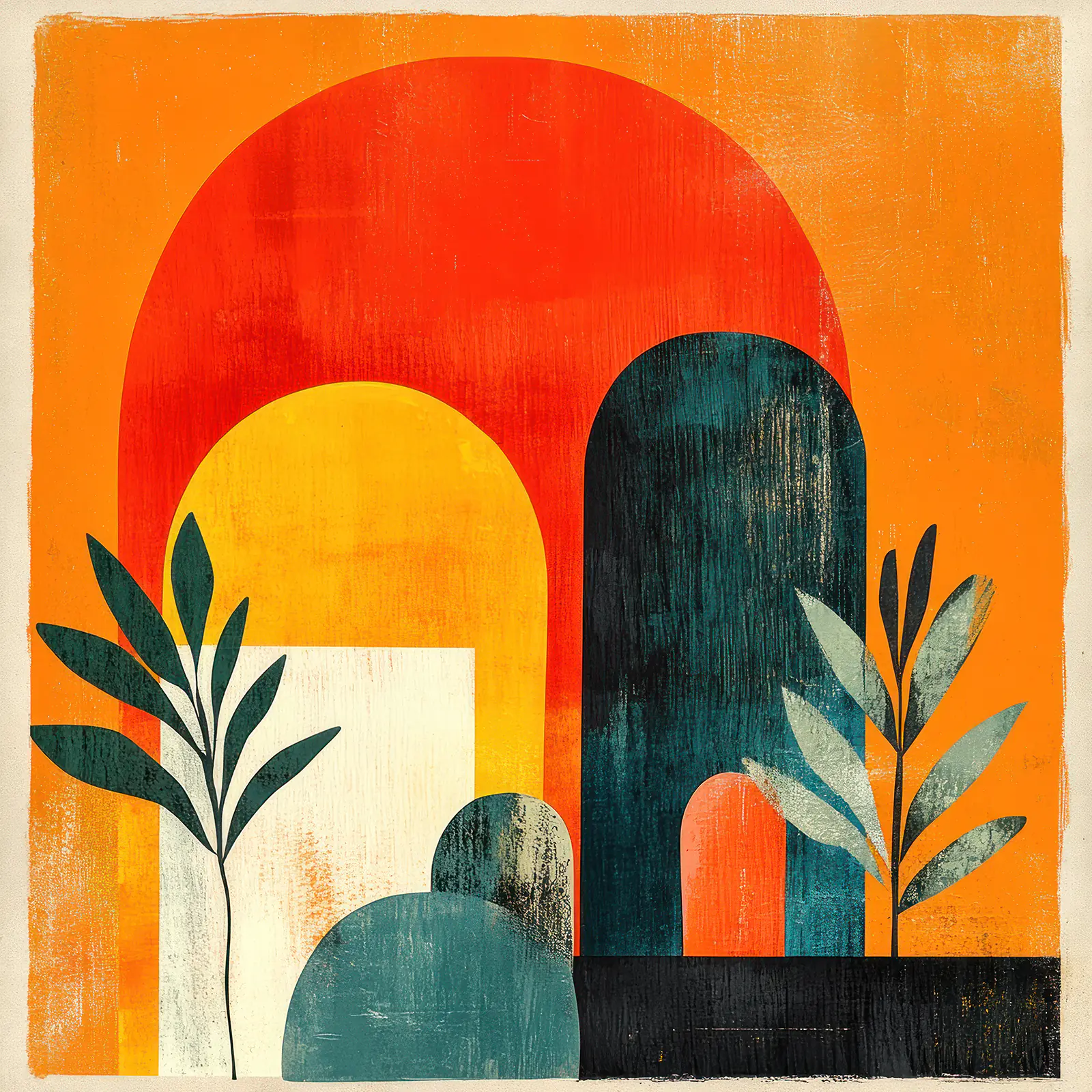
10 Retro Wall Art Ideas to Transform Your Space Instantly
There’s something undeniably magnetic about retro style—those bold colors, nostalgic motifs, and personality-packed designs that instantly transport us to another era. As someone who has curated retro collections for multiple spaces, I’ve seen firsthand how a single piece of well-chosen wall art can completely reshape the energy and character of a room. Retro design differs from vintage in significant ways; while vintage refers to authentic pieces from specific eras, retro incorporates design elements inspired by past decades—particularly the 50s through 80s—often with a contemporary twist. Understanding the difference between retro and vintage style helps create more intentional, cohesive spaces.
In this guide, you’ll discover ten retro wall art ideas that can instantly inject personality, color, and conversation-starting appeal into any room. From bold abstracts to nostalgic posters, these suggestions will help you transform your walls from blank canvases into expressive showcases of retro charm—no major renovation required.
Why choose retro wall art?
Retro wall art offers unique benefits that make it particularly appealing for modern spaces. These pieces serve as instant statement makers, cutting through minimalist trends with their bold patterns and vibrant color palettes. Interior designers frequently recommend retro pieces for their ability to inject personality into otherwise neutral rooms.
Beyond aesthetics, retro wall decor creates emotional connections through nostalgia. These pieces often reference cultural touchpoints that resonate deeply with us—whether that’s music, movies, or design movements that defined influential decades. This emotional resonance turns ordinary walls into meaningful storytelling opportunities.
Perhaps most appealingly, funky wall art from retro-inspired collections works surprisingly well across various decor styles. From mid-century modern to contemporary minimalism, these eclectic wall decor pieces create exciting visual tension that prevents spaces from feeling too predictable or catalog-perfect. They’re also increasingly popular among sustainability-minded decorators who appreciate art that references history rather than simply following fleeting trends.
1. Abstract retro posters
Abstract retro posters capture the boldest visual elements of the 60s through 80s—geometric shapes, saturated color blocks, swirling patterns, and confident compositions that command attention. These pieces work particularly well in spaces that need energy injection, bringing vibrant personalities to minimalist or neutral rooms that might otherwise feel flat.
The beauty of abstract retro artwork lies in its versatility and emotional impact. A single large-scale abstract with oranges, teals, and curved forms can transform a white-walled dining room into a vibrant entertaining space.
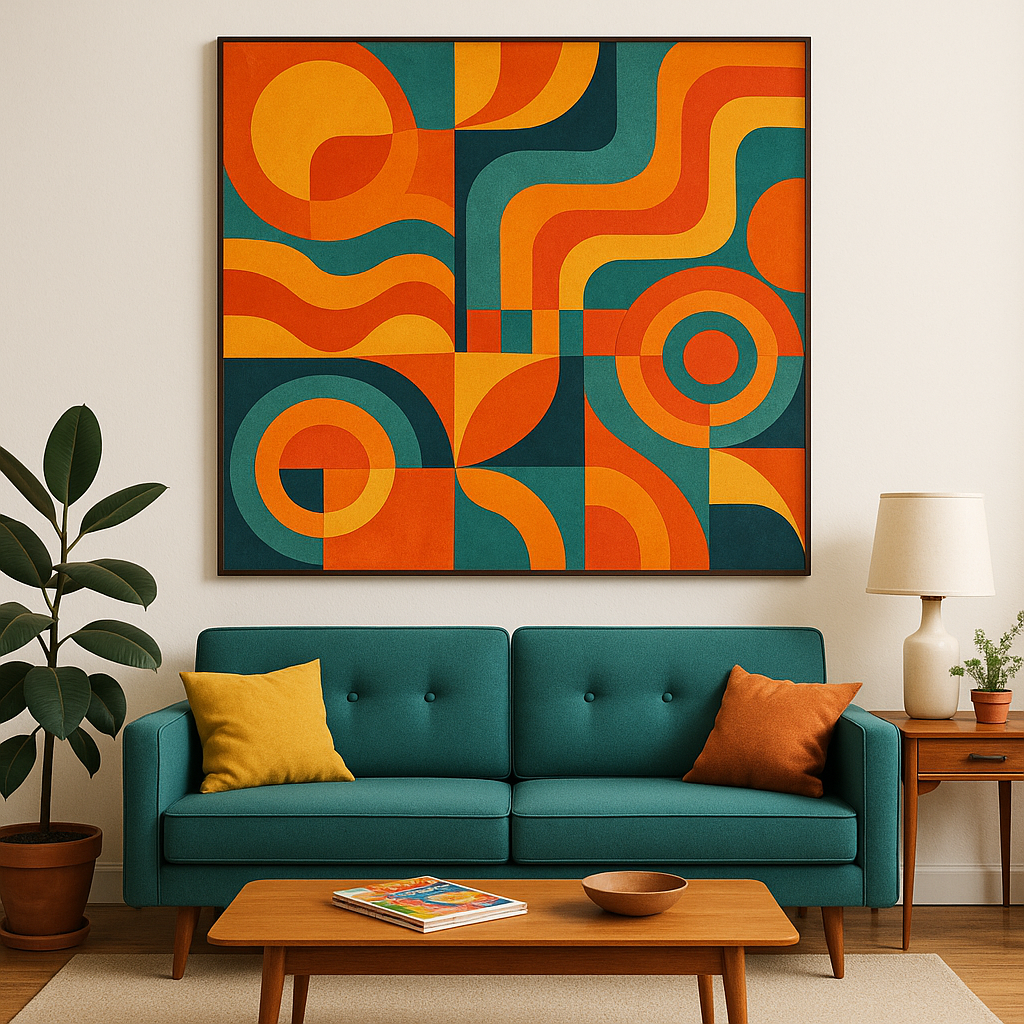
Similarly, a collection of smaller geometric prints in complementary tones can create rhythm along a hallway or staircase wall.
Where to source & how to display
For quality abstract retro posters, explore independent artists on platforms like Etsy where original designs abound. Specialty reproduction shops also offer faithful recreations of iconic 70s wall art patterns and compositions. For maximum visual impact, consider displaying abstract pieces above key furniture like sofas or beds where they can anchor the room, or use them to define zones in open-concept spaces.
Frame choice significantly affects how these pieces read in your space. For an authentic retro feel, opt for slim metal frames in gold or matte black, or embrace the era with chunky wood frames in teak or walnut tones. You can discover bold abstract retro prints here that come ready to transform your walls with their dynamic energy.
2. Mid-century modern prints
Mid-century modern art captures a distinctive era of design optimism through clean lines, organic forms, and sophisticated restraint. These pieces typically feature muted earth tones punctuated by strategic pops of color—think mustard yellows, olive greens, and burnt oranges against neutral backgrounds. What makes mid-century wall art so enduringly popular is its ability to feel simultaneously vintage and fresh.
In living rooms, a large-scale mid-century inspired print can establish the room’s entire color palette, informing fabric and accessory choices throughout the space. For home offices, these prints offer visual interest without the distracting intensity of bolder retro styles, creating productive atmospheres with subtle personality.
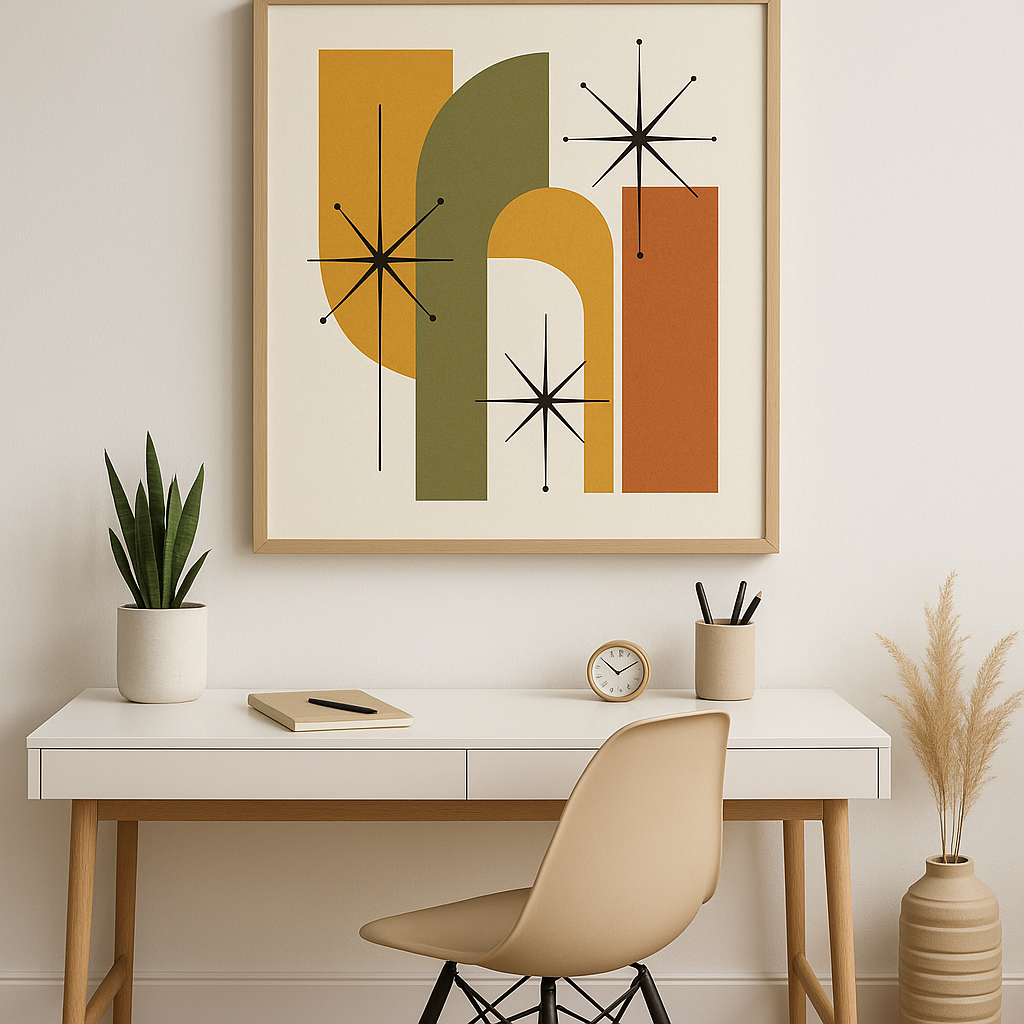
For authentic mid-century appeal, look for prints featuring starburst patterns, atomic motifs, or simplified nature elements like stylized leaves and organic shapes. Black and white photography from the era, particularly architectural shots or city scenes, also captures the mid-century aesthetic beautifully when framed in simple, clean-lined frames.
3. Vintage music & movie posters
Few retro wall art options carry as much cultural significance as vintage-style music and movie posters. These iconic pieces celebrate beloved albums, concerts, and films while instantly communicating your cultural interests to visitors. A carefully selected poster from a favorite 60s band or 70s cult film creates an immediate connection point for guests while surrounding you with imagery that resonates personally.
The aesthetic range within this category is vast—from psychedelic concert posters with their flowing typography to minimalist jazz album covers to technicolor movie advertisements. This diversity makes music and movie posters particularly well-suited for gallery wall arrangements, where you can mix various styles while maintaining thematic cohesion.
To elevate these posters beyond their dorm room associations, invest in proper framing with acid-free mats and UV-protective glass, especially for authentic vintage pieces that may fade. Consider arranging them chronologically to tell a story of musical or cinematic evolution, or group them by color palette for a more coordinated visual impact. These pieces work particularly well in entertainment spaces, home theaters, music rooms, or anywhere you gather with friends.
4. 70s psychedelic & pop art
The 70s unleashed some of the most distinctive visual styles in modern history, characterized by mind-bending psychedelic patterns and bold pop art techniques. These high-energy pieces feature swirling forms, vibrant color contrasts, and often a touch of the surreal. A single large psychedelic print can transform an entire room, creating an instant focal point that draws the eye and stimulates conversation.
Pop art from this era, with its cartoon-like graphics and cultural commentary, offers another distinctive approach to retro wall decor. Warhol-inspired prints with their repeating images and bright color blocks make particularly strong statements in kitchen and dining areas, bringing playfulness to utilitarian spaces.
For maximum impact, display psychedelic and pop art pieces against neutral backgrounds that allow their colors and patterns to take center stage. These styles pair surprisingly well with minimalist furniture, creating balanced tension between simplicity and exuberance. Consider placing these attention-grabbing prints in spaces where you entertain or gather rather than in restful areas like bedrooms, where their intensity might be overwhelming.
5. Retro travel & advertising prints
Vintage-inspired travel posters and advertising prints combine artistry with nostalgia in uniquely compelling ways. These pieces typically feature bold graphic compositions, simplified illustrations, and typography that instantly evokes specific decades. Travel posters from the 50s and 60s, with their optimistic depictions of destinations and transportation, bring a sense of wanderlust and possibility to your walls.
Retro advertising prints celebrate the distinctive visual language of bygone marketing—from classic soda advertisements to automotive promotions featuring futuristic styling. Beyond their decorative appeal, these pieces often incorporate humor and cultural references that make them natural conversation starters.
When displaying travel and advertising prints, consider creating meaningful connections to your own experiences or aspirations. A collection of destination posters representing places you’ve visited creates a personalized travel narrative, while vintage-style advertisements for products or brands you love adds a layer of personality to your decor. These prints work especially well in kitchens, dining areas, and transitional spaces like hallways or stairwells.
6. Funky gallery walls
Gallery walls offer the perfect opportunity to embrace the eclectic, playful spirit of retro design through thoughtful curation and arrangement.
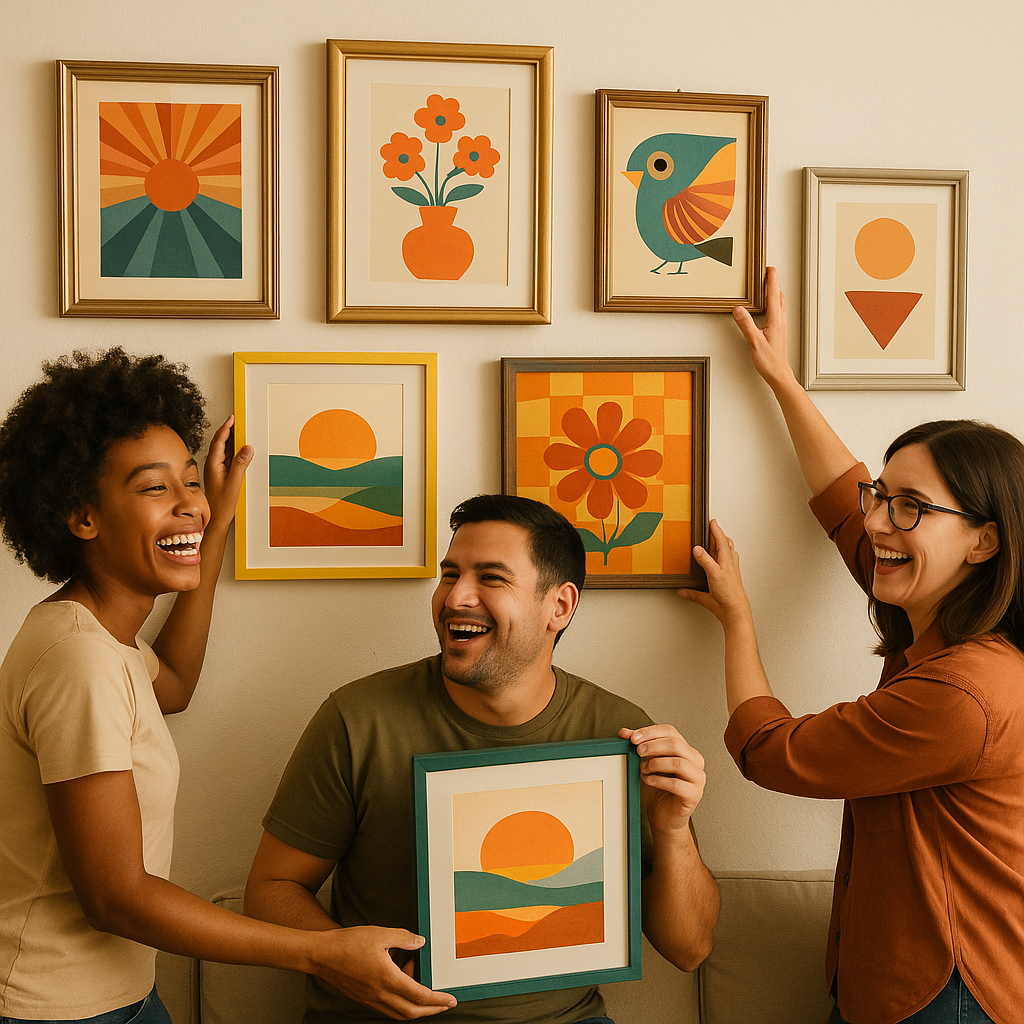
Unlike more formal or symmetric gallery displays, retro-inspired gallery walls thrive on deliberate mismatching—varying frame styles, mixed media, and diverse subject matter that somehow works together harmoniously.
The key to creating an effective retro gallery wall lies in finding a unifying element amid the intentional chaos. This might be a consistent color thread running through different pieces, a thematic connection between subjects, or simply a shared sense of era-specific style. Start with a central anchor piece—typically your largest or most visually striking item—and build outward, mixing professional art prints with thrifted wall art finds for authentic retro charm.
Frame selection plays a crucial role in establishing retro credibility. Consider mixing metallic frames with warm wood tones, incorporating some ornate vintage frames alongside simpler modern options. Don’t be afraid to include three-dimensional elements like small shelves displaying retro objects or shadowboxes containing vintage ephemera. You can enhance your home decor with original retro art prints that work perfectly within these eclectic arrangements, adding professional polish to your personalized collection.
7. Vintage-inspired fabric hangings
Textile wall art introduces texture, warmth, and acoustic benefits that traditional framed pieces can’t match. Retro-inspired fabric hangings—from bold geometric tapestries to intricate macramé creations—add dimensional interest to walls while softening a room’s overall feel. These tactile elements were hallmarks of 60s and 70s interiors, bringing organic texture to counterbalance the era’s harder materials like plastic and chrome.
Look for fabrics featuring quintessential retro patterns like oversized florals, psychedelic swirls, or geometric repeats in characteristic color palettes—avocado greens, harvest golds, and burnt oranges. Macramé wall hangings with their bohemian vibe work especially well in bedroom spaces or anywhere you want to create a sense of relaxed comfort.
For displaying fabric wall art, consider using decorative rods that become part of the artistic presentation, or stretch patterned fabrics over canvas frames for a cleaner look. These pieces are particularly effective in spaces that need acoustic improvement, like rooms with high ceilings or minimal soft furnishings. They also offer excellent solutions for rental properties where permanent wall modifications might be restricted.
8. Thrifted objects as wall decor
Perhaps the most authentic approach to retro wall decor involves repurposing genuine objects from past decades as artistic displays. Vinyl records, their large-format covers, and even the records themselves make striking wall installations when thoughtfully arranged. Vintage clocks, particularly the starburst and atomic styles of the mid-century era, function simultaneously as timekeepers and sculptural art.
Sustainability meets style when you transform outdated technology into wall art—radio faceplates, television components, or telephone parts create industrial-chic displays with historical significance. Even seemingly mundane items like vintage board games, typewriter components, or camera equipment can become compelling wall art when properly mounted and framed.
The key to elevating thrifted items from clutter to curated art lies in thoughtful presentation. Shadow boxes allow three-dimensional objects to be displayed safely while creating visual boundaries. Painting collection backgrounds in bold retro colors can unite disparate items. Arranging similar objects in grid patterns transforms individual pieces into cohesive artistic statements. For those who appreciate the aesthetic but lack thrifting time, you can also explore original art prints and retro posters that capture vintage object motifs in convenient, ready-to-hang formats.
9. DIY retro art projects
Creating your own retro-inspired wall art allows for complete customization while delivering major visual impact on minimal budgets. Color-blocking techniques offer perhaps the simplest entry point—tape off geometric sections on canvas and fill with flat retro colors like mustard, teal, and orange for instant mid-century appeal.
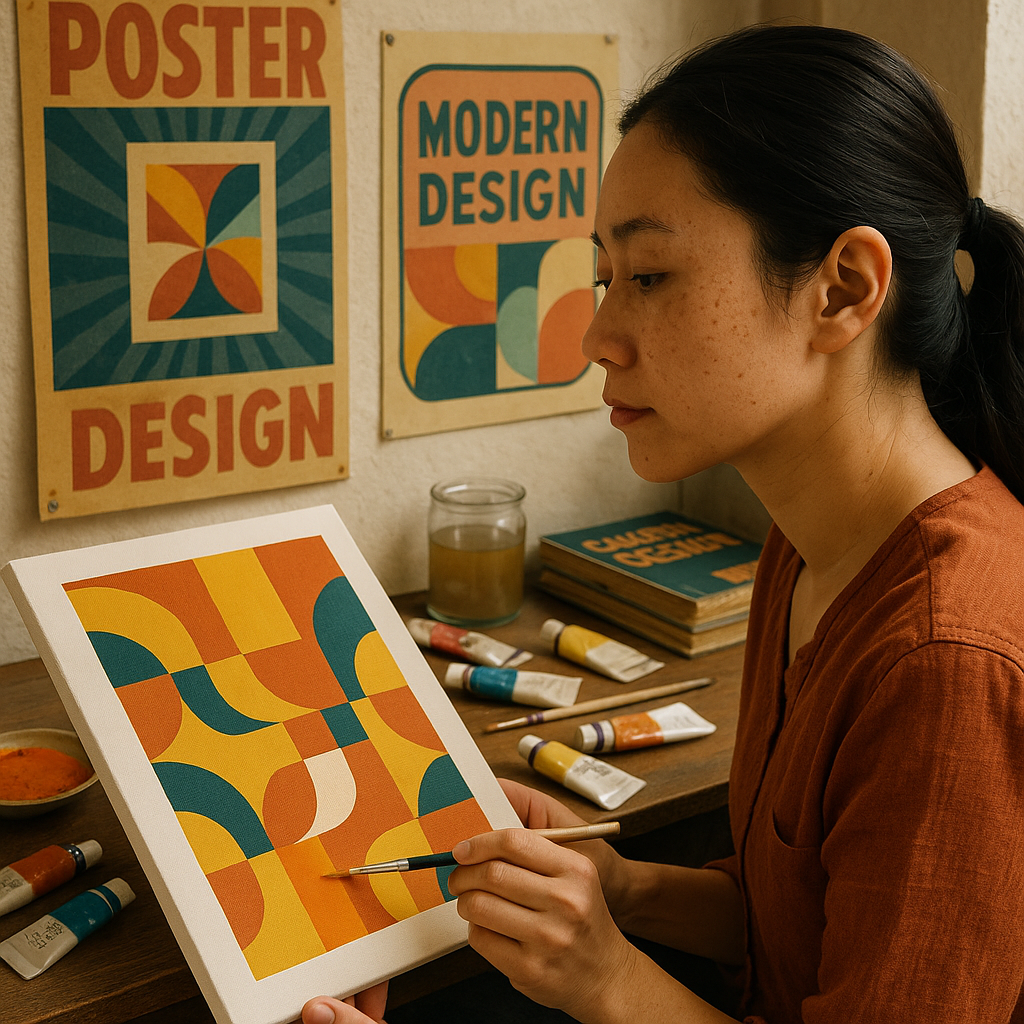
Stencils provide another accessible approach, allowing you to replicate characteristic patterns from different decades with precise edges.
For those comfortable with more advanced techniques, consider creating retro-inspired abstract paintings using techniques common in the 60s and 70s—fluid pouring methods for psychedelic effects or palette knife application for textured geometric compositions. Even simple line drawings can achieve strong retro aesthetics when executed in period-appropriate color schemes.
Upcycling provides another creative pathway. Transform thrift store paintings with strategic overpainting in bold retro colors, or decoupage vintage magazine images onto canvases or wood panels for authentic retro collages. Frame vintage fabric scraps, wallpaper samples, or even old sewing patterns for instant retro wall decor that carries genuine period texture and pattern. These personalized creations often become the most meaningful elements in your retro design scheme.
10. Personalized photo arrangements (retro-style)
Family photos and personal memories gain fresh visual appeal when displayed with retro styling techniques. Consider having digital photos printed with filters that mimic Polaroid aesthetics, faded film looks, or the distinctive color profiles of specific decades. Arranging these images in characteristic retro layouts—like asymmetrical clusters or radiating patterns—further enhances their period feel.
Frame selection dramatically influences how contemporary photos read as retro decor. Look for chunky plastic frames in bold colors for a 70s pop aesthetic, slim wood frames with rounded corners for mid-century vibes, or metal frames with distinctive geometric shapes for an atomic age feel. Creating consistent styling across different photos unifies them visually despite varying subject matter.
Get creative with display methods beyond traditional framing. Wire grids with clips allow for flexible, changeable photo arrangements with an industrial edge. Hanging strings with clothespins create casual, bohemian displays perfect for Polaroid-style prints. Grouping photos in vintage plate frames or repurposed windows adds architectural interest while showcasing precious memories. These personalized photo arrangements work particularly well in bedrooms, family rooms, or anywhere you want to combine decorative impact with emotional resonance.
Conclusion
Retro wall art offers an unmatched combination of visual impact, personal expression, and transformative potential for your living spaces. Whether you’re drawn to the clean lines of mid-century abstraction, the playful energy of 70s psychedelia, or the cultural touchpoints of vintage advertising, these distinctive styles instantly inject character and conversation-starting appeal into any room.
What makes retro wall art particularly appealing is its accessibility—these ideas can be implemented across various budgets, from high-end collector pieces to thrifty DIY projects. The sustainable aspect of embracing retro aesthetics also aligns perfectly with contemporary values, celebrating design history rather than disposable trends.
As you consider which retro wall art ideas might work in your space, remember that authenticity comes not just from accurate period references but from meaningful personal connections to the pieces you display. The most successful retro-inspired spaces tell stories about the people who inhabit them while creating visual environments that feel simultaneously fresh and familiar.
Frequently asked questions
What is the difference between retro and vintage wall art?
Retro refers to styles inspired by but not made in past decades (usually 50s–80s); vintage is original to the era. See our breakdown of the difference between retro and vintage style.
Can I mix retro wall art with modern decor?
Absolutely! Retro pieces add color and playfulness to contemporary settings. Try pairing clean-line furniture with a bold graphic poster for a chic contrast.
Where can I buy high-quality retro wall art?
Explore curated collections online (see our recommended retro posters and prints) or check out local thrift and vintage stores for unique finds.
How should I arrange different retro wall art pieces?
Aim for balance by mixing large focal pieces with smaller accents. Use cohesive color palettes or themes for a unified look.
Are retro wall art ideas budget-friendly?
Yes! DIY projects, digital prints, and thrifted items can offer big visual impact without a hefty price tag.